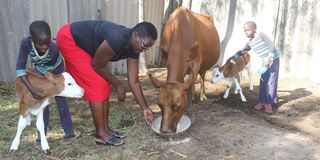Farmers need to avoid adopting advice wholesale

A farmer feeds a cow and its twins. The birth of twins, triplets or quadriplets is rare in cattle. It happens by coincidence where more than one egg is released at ovulation.
What you need to know:
- Kenyans often ask me if there is not a single way prescribed for livestock farming they can always refer to.
- I once found a farmer who was inseminating her cows with three semen straws or doses every time.
No one has a monopoly of knowledge. Not even experts. I have, however, seen livestock farmers being confused by an overload of advice and abandoning their working practices to shift to unproductive or even loss-generating ventures.
Kenyans often ask me if there is not a single way prescribed for livestock farming they can always refer to.
They are concerned that there are disagreements even among professionals on what works best.
So, why is livestock farming burdened with many versions of what works and what does not?
The answer lies in the nature of biological assets, meaning the animals, nefarious organisms such as micro-organisms and parasites, feeds and the physical environment.
Biological assets and the physical environment have many variables such that a science layman may not tell the effect a change on any would have on their livestock.
Further, there is the human quest for knowledge and desire to get the best out of livestock.
This quest drives farmers to apply some advice even when they may not have been convinced that it would be beneficial.
Finally, there is the matter of individuals masquerading as experts or specialists in livestock production and health; coupled with some experts attempting to outdo one another to appear to be the best.
Some advice I have encountered borders on the absurd.
I once found a farmer who was inseminating her cows with three semen straws or doses every time.
She had been advised to learn how to inseminate her cattle so that she could save on the cost, as well as improve the efficiency of insemination since she was always on the farm.
I asked the farmer if she had ever come across triple-dose insemination recommended in cattle breeding during her inseminater’s training or in her private reading.
She told me one of her farmer friends had said she had even got twins from the technique.
The farmer briefing me had used more than 200 doses of semen but there was not a single multiple calving in her herd of 60 cows.
I explained to her that she had been wasting her money and effort and risking infection of the reproductive system of her animals.
Every time the insemination tube is inserted into the uterus, there is a risk of introducing infection due to bacteria or injury to the lining of the reproductive tract.
Taking the risk once is acceptable but two more times for the same heat is unethical and unacceptable.
I told the farmer to remember that a bull deposits millions of sperms in the cow’s reproductive tract but only one of the sperms fertilises the egg.
Once fertilisation takes place, the egg becomes unresponsive to all the other sperms and they just die off. If an error occurs and two sperms fertilise one egg, the embryo would most likely die because it is biologically unfit to develop into a calf.
Moreover, birth of twins, triplets or quadriplets is very rare in cattle.
It is genetically controlled or happens by coincidence where more than one egg is released at ovulation during heat.
At another farm in Kiambu County, I found a farmer feeding 15 kilogrammes of dairy meal to cattle, apparently to challenge his animals to produce to their full potential!
He had called me because the cows progressively got thinner, eventually died. Their internal organs had rotten over time.
This was another case of wastage of feed resources and poisoning of the animals with too much carbohydrates.
The problem is called subacute rumen acidosis or SARA. I explained to the farmer that feeding challenge is done up to the limit prescribed for the protein, carbohydrates, minerals and vitamins for the cattle.
Beyond those limits, the nutrients become toxic and death may occur if overfeeding continues for long.
I investigated the self-proclaimed expert who had given the farmer advice and discovered he was a fraud selling dubious vitamin concoctions to unsuspecting livestock owners.
A farmer in Murang’a spent a lot of time and resources tracing a “nutritional expert” all the way to Kisumu.
He found the man had some cattle that looked well fed and taken care of.
When the farmer explained to the “expert” how he fed his cattle, he was advised to only look for fish meal and cotton seed as his protein source. Everything else was said to be useless. The farmer was not convinced with the advice as he had also done some research and consulting.
I told the farmer to use protein sources most readily available and cheapest to him.
There are many protein sources that one can use for dairy cattle feed, including sunflower, Lucern, super Napier and soya bean.
To avoid information overload and confusion, farmers should seek to equip themselves with credible livestock knowledge from reputable sources.
These include renowned agricultural publications, institutions and verifiable experts such as specialised farmers.





